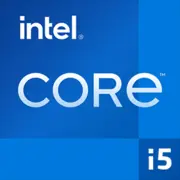Intel Core i5-8400T

Intel Core i5-8400T: 古くてもまだ現役の予算向けプロセッサーのレビュー(2025年)
2025年4月
1. 主な特長: Coffee Lakeアーキテクチャとほどほどの性能
Intel Core i5-8400Tプロセッサーは2017年に発売され、Coffee Lake世代に属します。古いモデルでありながら、低電力消費と安定性のおかげでニッチな人気を保っています。
- アーキテクチャとプロセステクノロジー: 14nmプロセス(最適化されたFinFET版)、物理コア6つ、ハイパースレッディング非対応(スレッド6)。ベースクロックは1.7GHz、Turbo Boostで最大3.3GHz。
- キャッシュとTDP: L3キャッシュは9MB、熱設計電力は35W。これにより、コンパクトなPCやパッシブ冷却システムに最適です。
- 統合グラフィックス: Intel UHD Graphics 630(ベースクロック350MHz、最大1.05GHz)。4K出力や要求の少ないタスクに適しています。
- 性能: Geekbench 6(2025)のテストでは、シングルスレッドで1097ポイント、多スレッドで3890ポイントを記録。比較すると、現代の予算向けRyzen 5 7500(Zen 4)は約1800/8500ポイントです。
主な特徴:
- エネルギー効率(TDP 35W)。
- 4Kビデオのハードウェアデコード (HEVC、VP9) に対応。
- Windows 7を含む古いOSと互換性があります。
2. 対応マザーボード: LGA 1151 v2ソケットと制限された機能
i5-8400Tは、LGA 1151 v2ソケットを使用しており、300シリーズのチップセットのみと互換性があります:
- H310 / B360 / H370: オーバークロック非対応の予算向けボード(例: ASUS Prime B360M-A)。オフィスPCに適しています。
- Z370 / Z390: メモリオーバークロックとPCIe 3.0 x16のサポートを提供。ただし、プロセッサ自体はオーバークロックがブロックされています。
選択のヒント:
- ミニPC向け: Mini-ITXボード(例: Gigabyte H370N-WIFI)。
- アップグレード用: BIOSでCoffee Lakeのサポートを確認(すべてのZ370ボードが更新されているわけではありません)。
- 価格(2025年の新しいボード): $60(H310)から$150(Z390)まで。
3. 対応メモリ: DDR4のみ
プロセッサはDDR4-2666(公式サポート)で動作します。最大容量は64GB(マザーボードに依存します)。
推奨事項:
- オフィス用タスク: 8~16GB(2x4GBまたは2x8GB)。
- マルチメディア用: 16~32GB + デュアルチャネルモード。
- DDR5はサポートされていません—これが2025年の主な制限です。
4. 電源ユニット: 最低300W
TDPが35Wにもかかわらず、完全なシステムは約100~150Wを消費します(エントリークラスのグラフィックカードを使用した場合)。
ヒント:
- 専用グラフィックスなしの場合: 300W電源ユニット(例: be quiet! SFX Power 3 300W)。
- グラフィックカードあり(例: GTX 1650): 400~450W電源ユニット(Corsair CX450)。
- 重要: 安定性のために80 Plus Bronze以上の認証を受けた電源ユニットを選択してください。
5. 2025年時点でのi5-8400Tの長所と短所
長所:
- 低い電力消費と熱発生。
- 基本的なタスクに対して十分な性能(オフィス、ブラウザ、4Kビデオ)。
- 統合グラフィックスが付属。
短所:
- ハイパースレッディングがないため、多スレッド性能で劣る。
- 古いアーキテクチャ(14nm vs. 競合の5~7nm)。
- PCIe 4.0/5.0およびDDR5をサポートしていない。
6. 使用シナリオ: 誰にとって有用なプロセッサーか?
- オフィスPC: 文書作成、ビデオ会議。
- メディアセンター: HDMI 2.0を介した4Kストリーミング(Netflix、YouTube)。
- 軽いゲーム: CS:GO、Dota 2を低設定で(30~60 FPS)+ GTX 1050 Tiレベルのディスクリートグラフィックス。
- エントリーレベルのサーバー: Proxmoxを基にしたNASまたはホームサーバー。
実例:
あるユーザーは、i5-8400Tを搭載したHTPCをSilverstone ML05ケース(価格80ドル)で組み立て、パッシブ冷却を行いました。システムはアイドル時に25Wを消費し、4K HDRを処理しています。
7. 競合との比較: Ryzen 5 2400Gなど
- AMD Ryzen 5 2400G(2018): 4コア/8スレッド、Vega 11。マルチタスクやグラフィックスでは優れていますが、TDPは65W。価格(2025年、新品): $90~110。
- Intel Core i3-12100T(2023): 4コア/8スレッド、10nm、TDP 35W。シングルスレッドタスクでは30%速い。価格: $130。
結論: i5-8400Tは現代のアナログには劣りますが、中古市場では価格面で優位に立っています($40~60)。
8. 組み立てに関する実用的なヒント
- 冷却: 標準クーラーで十分ですが、静音システムが必要な場合はNoctua NH-L9iを選択してください。
- ケース: ミニPC用にはFractal Design Node 202; オフィス用には任意のMicroATX。
- SSD: NVMeストレージを必ず取り付けましょう(ボードがサポートしていない場合はPCIeアダプタを経由して)。
9. 最終結論: i5-8400Tは誰に向いているか?
このプロセッサーは以下の2つのケースで検討すべきです:
1. 古いシステムのアップグレード(LGA 1151 v2ソケット)。
2. オフィスまたはメディアセンター向けの予算組み立てで、電力効率が重視される場合。
2025年時点で、i5-8400Tは特定の作業に適した「ワークホース」でありますが、ゲームや本格的なマルチタスクには向いていません。予算が$300~$400に制限されている場合は、最新のi3またはRyzen 3でDDR5とPCIe 4.0をサポートするものを選んだ方が良いでしょう。
基本
CPUの仕様
メモリ仕様
GPUの仕様
その他
ベンチマーク
他のCPUとの比較
ソーシャルメディアで共有する
または当サイトへのリンクを追加
<a href="https://cputronic.com/ja/cpu/intel-core-i5-8400t" target="_blank">Intel Core i5-8400T</a>